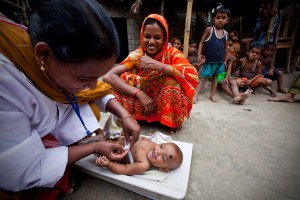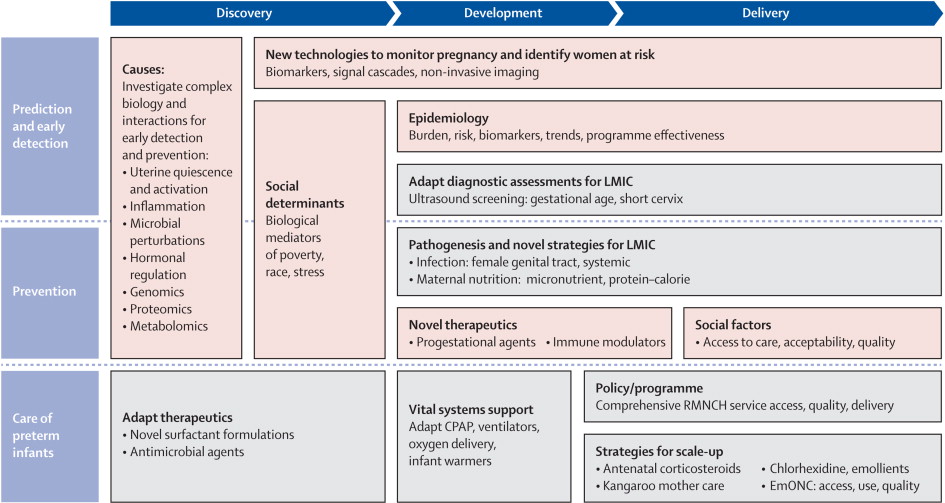A Solution Pathway for Preterm Birth

By Sarah B. Alexander
Director of External Relations, Global Alliance to Prevent Prematurity and Stillbirth (GAPPS), an initiative of Seattle Children’s
When Megan suddenly goes into labor at just 25 weeks gestation, she rushes to the hospital and gives birth to Sophia 15 weeks early. Sophia is transferred into the hospital’s Neonatal Intensive Care Unit and put in an incubator, which allows her time to grow and develop enough to be able to function on her own. She has to undergo several surgeries over the following months, but the doctors say her outlook is good.
However, when Mary goes into labor, also at 25 weeks, she has no way of getting to the hospital. Her family doesn’t have a car and the nearest health clinic is miles away. In a remote village, she gives birth on the dirt floor of her hut to a daughter, Rose, who weighs less than a pound. With immature lungs, Rose struggles to breathe in a world she was not prepared for, and does not survive the night.
Depending on where in the world a preterm birth occurs, it can be anything from a speed bump to a death sentence. The allegorical stories of Sophia and Rose provide a glimpse into similar situations that occur millions of times every year.
Babies born prematurely in high-income countries have access to the best technology and highly skilled doctors, giving them a good chance of survival. In middle-income countries, survival rates for preterm babies are somewhat lower. However, those who do survive face much higher rates of enduring health problems, from asthma to cerebral palsy to developmental delays. The situation is worst in low-income countries, where mothers may not have any access to health facilities or trained health workers. The risk of a neonatal death due to complications of preterm birth is at least 12 times higher for an African baby than for a European baby1. This is where frontline health workers can step in to fill the gap and oftentimes be the difference between life and death.
It is heartbreaking to know that there are low-cost interventions to manage preterm birth and care for preterm infants, but without enough frontline health workers and without implementation of known interventions, more than a million preterm babies die every year.
In a global call to action, scientific experts from the Bill & Melinda Gates Foundation, the Eunice Kennedy Shriver National Institute of Child Health and Human Development, GAPPS, and the March of Dimes Foundation published in Lancet Global Health A solution pathway for preterm birth: accelerating a priority research agenda.
The solution pathway includes critical steps in development and delivery science that can help scale up interventions to improve the survival of preterm infants in low- and middle-income settings. Key to implementation are the frontline health workers that deliver care, including the solutions outlined below, in the most remote and inaccessible parts of the world:
Practical solutions need to be developed and moved to scale to improve care. An expanded implementation science agenda will accelerate application of effective strategies at the community and facility level, including antenatal corticosteroids, newborn resuscitation, kangaroo mother care, nutrition, intrapartum monitoring, newborn skin emollients, chlorhexidine cord care, preconception care, and strengthened commodities and essential drug programmes. Adaptations of interventions for newborn care are needed..
- Lackritz et al, Lancet Global Health, Vol. 1, No. 6, Dec. 2013
The schematic below summarizes key elements of the solution pathway for preterm birth research, across the range of discovery, development, and delivery science. The agenda is global in its approach; strategies more relevant to high-income countries are in pink, and low-income and middle-income countries (LMIC) are in grey. The full graphic is available in the Lancet article here.
The solution pathway outlines a shared research agenda to address the global burden of preterm birth, which has become the leading cause of newborn death. By harnessing the political will and expanding investment in healthcare delivery by frontline health workers, we can dramatically improve the outcomes for millions of babies like Rose who are born prematurely around the world.
References:
- Born Too Soon: The Global Action Report on Preterm Birth (2012).


